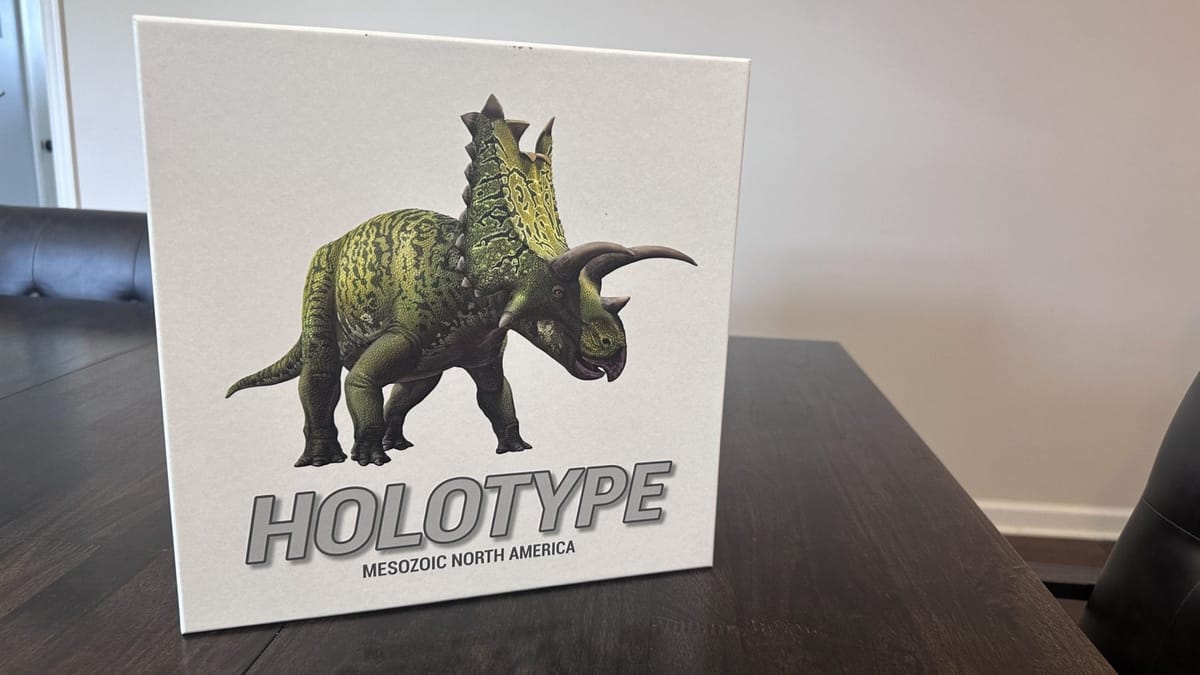
Have you ever wondered what it would be like to be a paleontologist out in the field digging up dinosaur bones and trying to figure out if you’ve just discovered a new species? Holotype: Mesozoic North America by Brexwerx Games puts you in the dirt and looking for those bones.
Holotype is a straightforward worker placement game but with a bit of twist (I’ll get to that in a while), some set collection and some goal chasing as well. Designed for 2-5 players, one of the better features in my opinion is that there is a different main playing board for each player count – rather than having one board where you have to block off placement spots based on player count. It’s a minor thing, but scores points with me.
MEEPLES
The first thing to note is that in this worker placement game, each of your three meeples are not only physically different sizes, they represent different roles within paleontology. You will have your paleontologist, a field assistant and finally a grad student. You start the game with the first two and earn the third once you’ve published your third holotype. The cool mechanic with these three is that they are three different heights, and during game play you can use the same size or a larger role to bump a meeple from a worker placement area and take that action. This will push your opponent’s meeple back to his lounge to use on another turn. In this way, you have a continuous flow of actions and never have a round reset. Finally, each action you take will have a different power based on which one is utilized – as each role has a greater knowledge of paleontology.
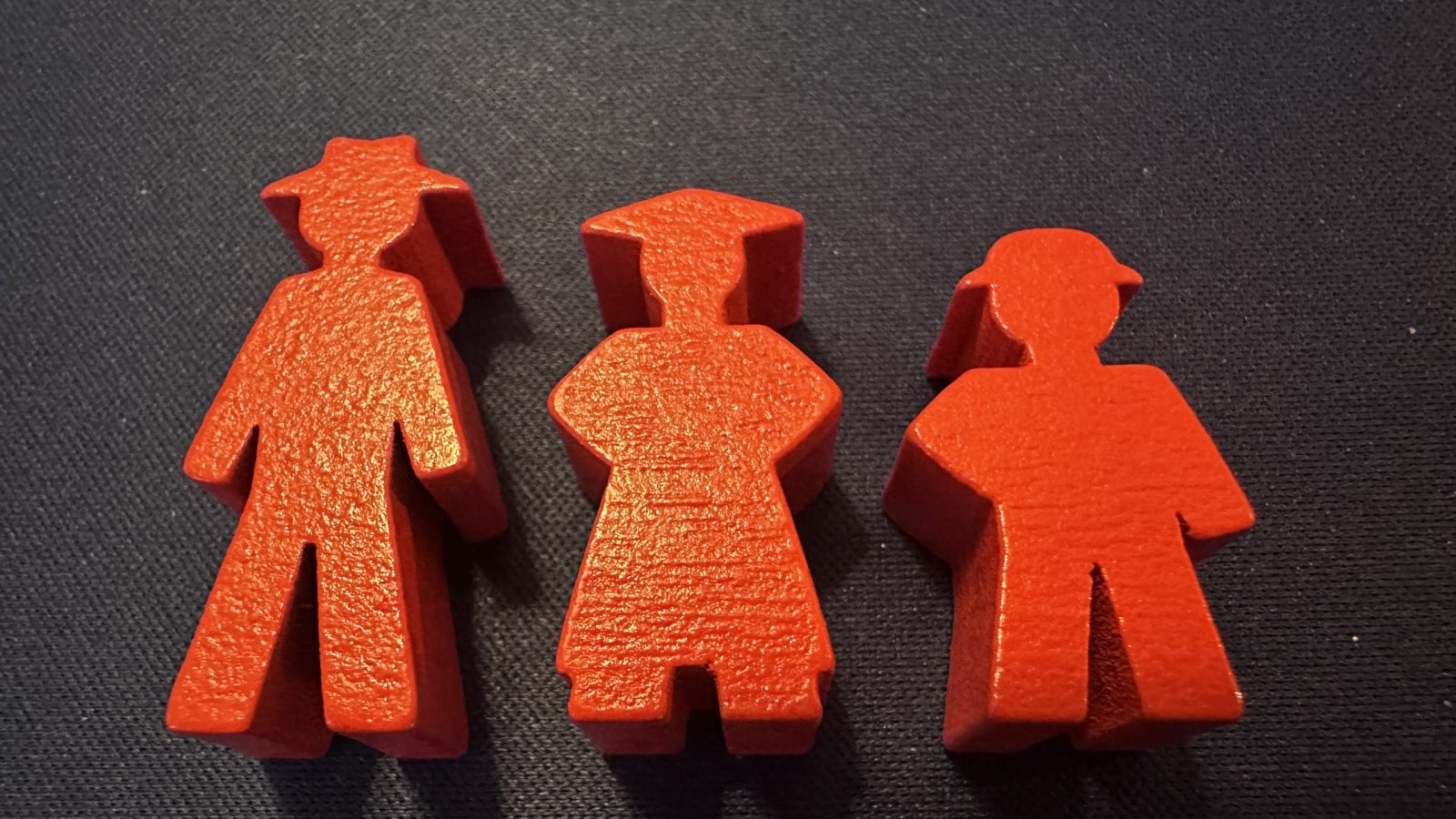
Paleontologist, Grad Student and Research Assistant meeples.
GAME BOARDS
That brings us to the different boards in this game. There are three boards to concern yourself with in Holotype, each with their own features. The first is the main board, simply called the “game board”, which is where the worker placement activities will happen. The board is separated into 5 distinct sections with different number of action spots depending on the player count.
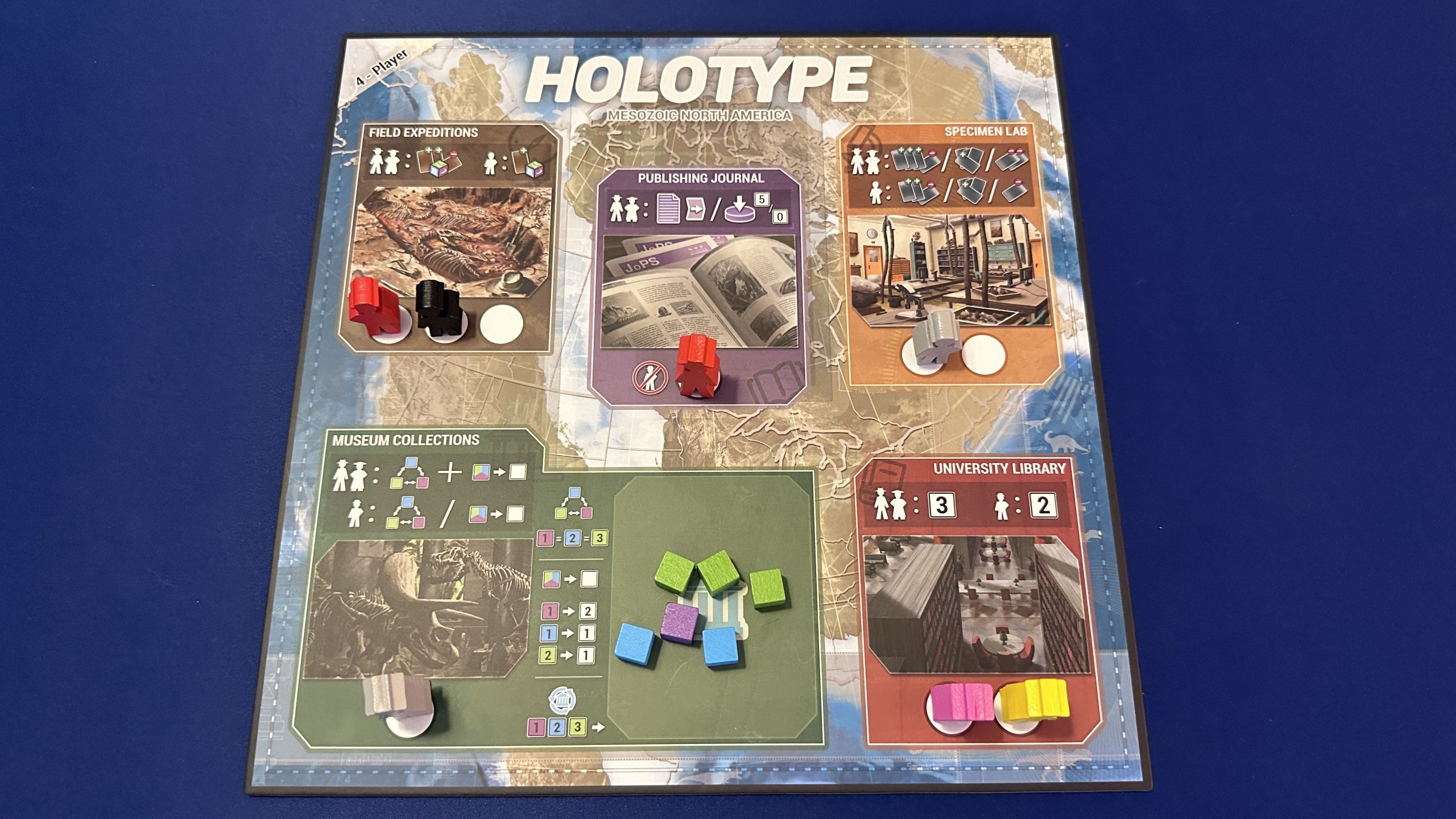
Four player board with meeples in action locations and Museum Collections set up
The five areas allow you to take the following actions:
- Specimen Lab – Gain Specimen cards by drawing cards into your hand, these will be used to fulfill as holotypes with the requisite fossils and research cubes.
- Field Expeditions – Gather new fossils by drawing a location and rolling fossil dice, gaining the color coded cubes for the location and die results. These will be needed when you go to publish a holotype.
- University Library – Gather new research cubes, which will be required in order to publish your holotype or use other players’ holotypes towards global objectives.
- Publishing Journal – Exchange your specimen card, research cubes and fossil cubes as indicated on the card to publish a holotype; or contribute to a global objective card if you have met the requirements, taking a marker from your player board to cover and claim it.
- Museum Collections – Exchange your fossil and/or research cubes with those available in the board location to get the cubes you need to publish.
Each location has meeple restrictions or magnitude adjustments, for example the Publishing Journal can only be accessed by your paleontologist and, once unlocked, your grad student. Thematically, it shows the advanced knowledge and abilities of these roles over the field assistant.
The second board to keep track of is the Field Advancement track. Displayed next to the main board, this track will move every time any player takes the Publishing Journal action to publish a holotype. It serves a couple of additional purposes as well. First, it will act as the end game countdown. One of the end game triggers is having published between 18-36 total holotypes amongst all players dependent on player count. Along the way on the tracker there are museum icon spaces which allow you to reset the cubes available in the Museum Collections main board location, and spaces with a star icon which allows all players to unlock a milestone on their player board.
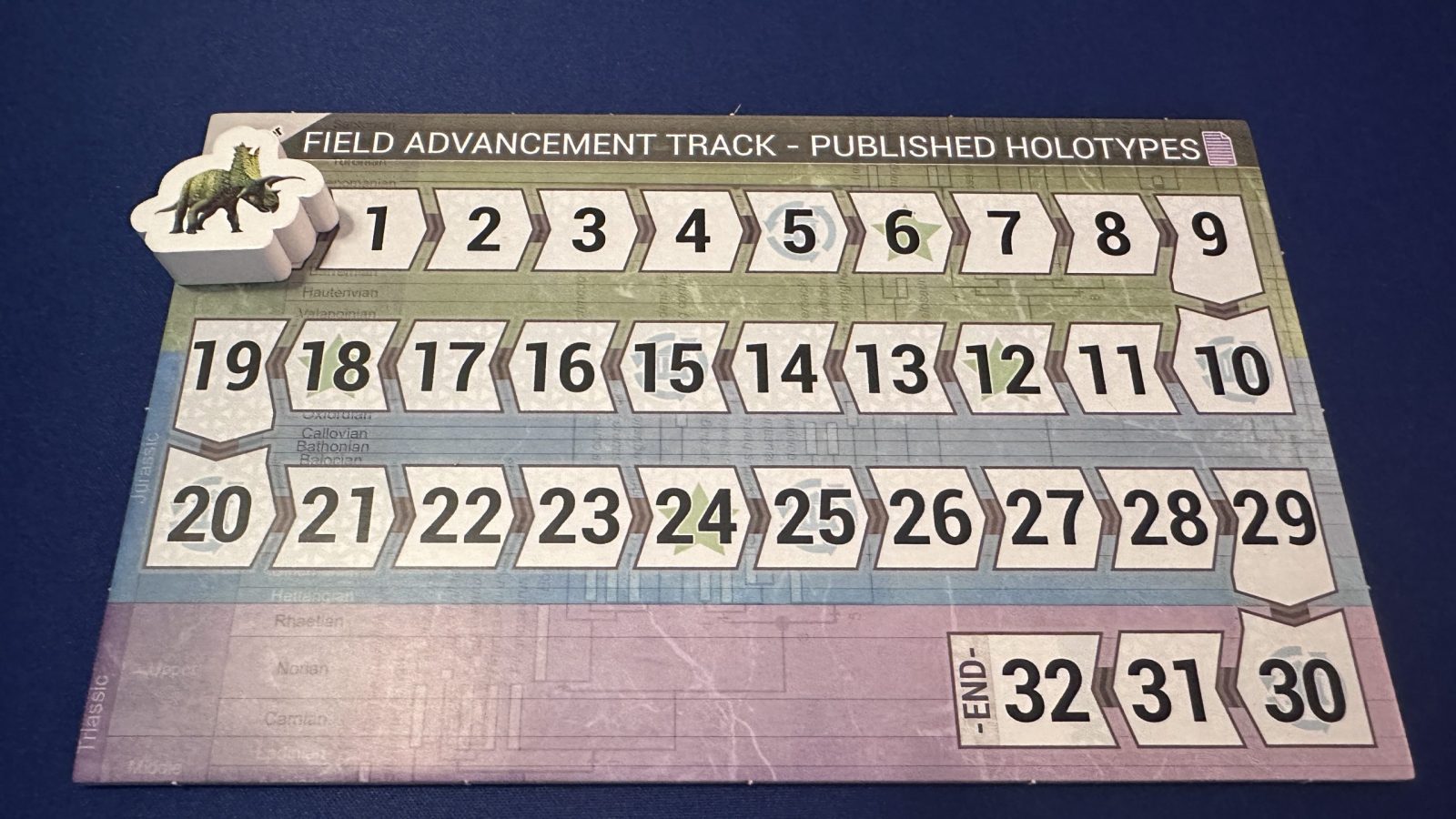
Field Advancement Track for published holotypes, 4 player board.
Finally, you have your player board. This is divided into five sections as well:
- Lounge – the waiting room for your meeples until you play them, or if they are bumped back to your board. With no strict round structure, on your turn you’ll either play a meeple from this location to take a main board action or gather all your meeples from the board back to your lounge.
- Research Tokens – white cubes go in this area, and you can have infinite quantities stored here.
- Fossil Storage – you are limited to eight total fossil cubes in this area. The fossils are color coded to three periods within the Mesazoic era: Triassic (purple) cube, Jurassic (blue) cubes, and Cretaceous (Green). As the Triassic period is much older, these cubes are rarer than the Jurassic or Cretaceous thematically, so they’ll be tougher to obtain during Expeditions and harder to exchange for in the Museum Collections.
- Global Objective Contribution – each player 5 five markers and each one removed will score you additional points at the end of the game, with a max of 35 points available to earn if you contribute all 5 to the global objectives.
- Milestone Achievements – as noted above, as more holotypes are published it will unlock Milestones for all players. Each player has 6 different milestones to choose from to provide in-game boosts to their actions. During the game you will be able to select 4 of the 6 to add to your player board, providing possibilities for asymmetric abilities if players select different boosts.
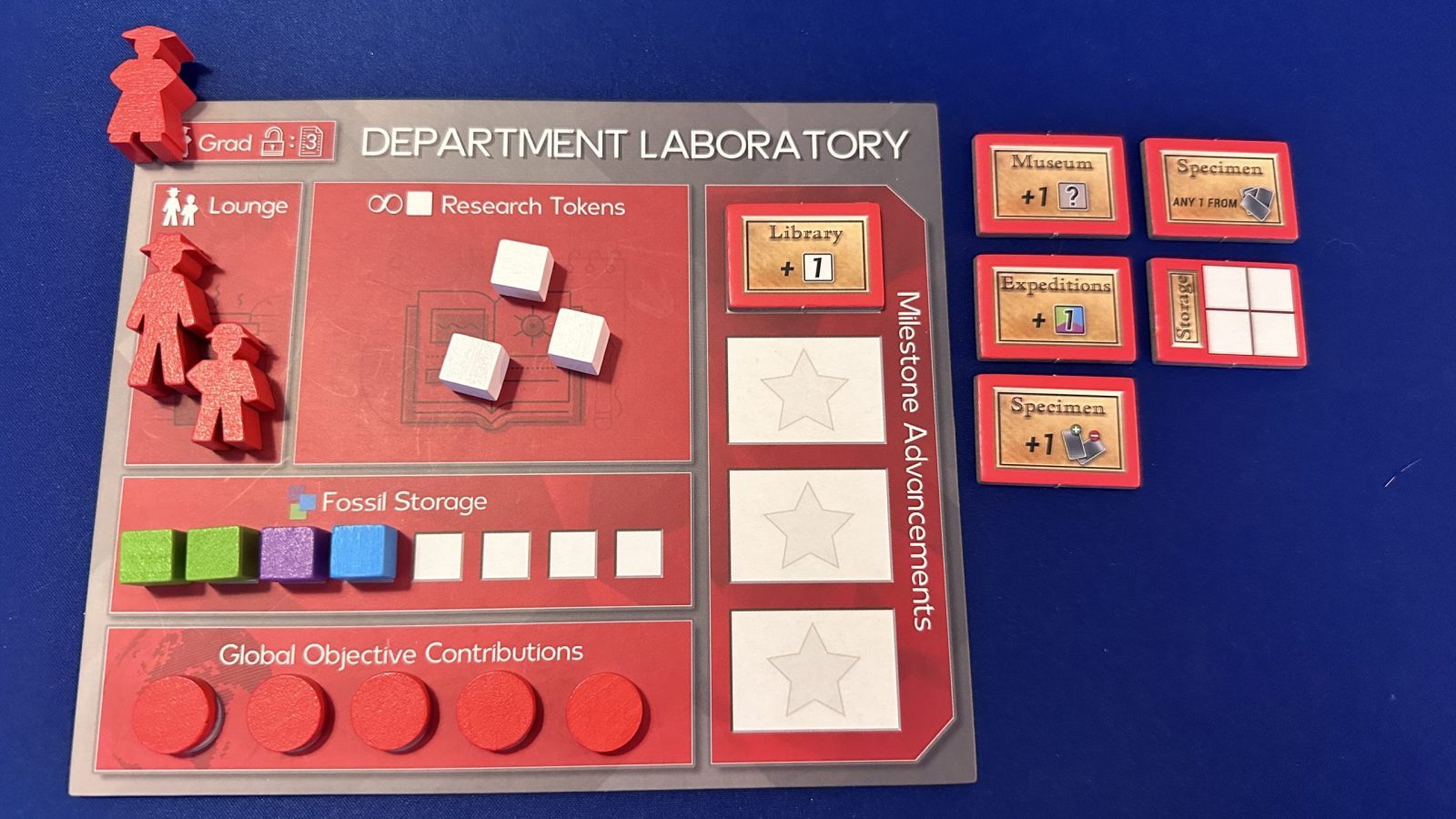
Red player board set up.
CARDS
Finally, there are four decks of cards that will shape the game:
- Global Objectives – at the beginning of the game, you will display a number of these equal to the number of players plus one. Each of these cards will have 2 or 3 objectives that can be claimed by any player and will be based on the holotypes collectively or individually published. If you wish to use other players’ holotypes toward fulfilling one of these objectives, you also need to turn in 5 research cubes. The second end game trigger is when a number of these cards equal to the number of players is completely filled.
- Specimen Cards – each player starts with three in hand, and can draw more at the Specimen Lab. This card will tell you how many fossil cubes, the color needed, and the number of research cubes needed to publish that holotype. Additionally, it will have icons for the diet, victory point value and type of dinosaur the specimen is – these criteria may apply towards the global objectives.
- Expedition Cards – when visiting the Expedition location on the main board, you’ll draw the applicable card(s) and visit a location allowing you to roll the color coded dice and take the resulting fossil cubes from the supply to store on your board.
- Personal Objectives – at the start of the game, each player gets 2 personal objective cards and keeps one to be scored at the end of the game. This will give everyone a goal to chase during the game.
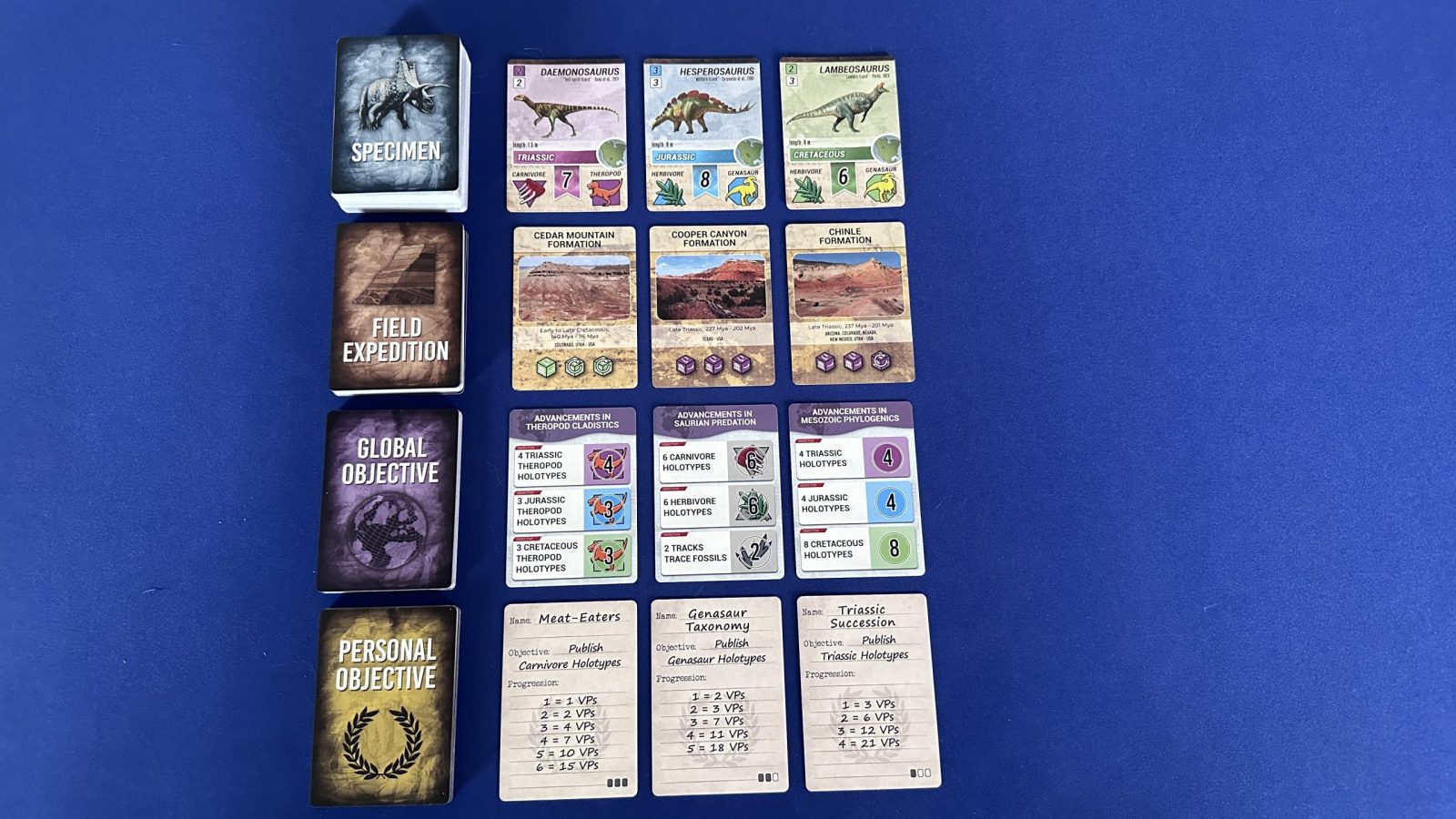
Specimen, Expedition, Global Objectives and Private Objectives examples.
STRATEGY
Ultimately, you’re working to publish as many holotypes as possible and claim the global objectives. With each holotype being worth victory points, and claiming 5 global objectives being worth 35 points, this is where a bulk of your scoring will take place. Maximizing the effectiveness of your meeple placements is important as well, taking advantage of the stronger actions of your paleontologist and grad student, while also possibly blocking some action spots from your opponents by using these two when you see that your foe only has their field assistant available to play in their lounge can give you a bit of an upper hand. One of my favorite wrinkles in the strategy is that you can use other players’ holotypes towards the global objectives, which feels rather thematic with scientists building on the research of others and crediting them in their work.
COMPONENTS
This is where the game disappoints me as a gamer. Yes, the different main boards provided by player count are a plus. However, the rest of the game components and actual board designs were rather underwhelming. In the grandiose world of dinosaurs, the possibilities for fossil resources had such potential for cool components like thematic bones or something other than plain painted cubes. The player boards, milestones tokens and field advancement tracker board are very basic and lack any discernible artwork. Just feels like a big missed opportunity to make the game visually enticing and tactile. The three types of meeples for the different roles are nice, they are distinct and make it easy to know which of the three roles you’re currently working with for your action. However, in an industry known for massive overproduction of components, it’s surprising to find a game so under-produced especially in this genre.
Holotype : Mesozoic North America
Good
Holotype Mesozoic North America is a fun worker placement game, with some very thematic elements along the way that make sense beyond just game play. The jockeying for positions, bumping opponents from placement locations and ultimately publishing your holotypes makes for a fun and interactive experience with the other players at the table.
Pros
- Interactive - there is a ton of interaction between players, always a plus for me.
- Worker Placements - Meeple sizes/roles and bumping opponents is fun and keeps the game moving.
- No Rounds - Game is played in a continuous cycle of placing, bumping and removing workers.
Cons
- Design - under-produced elements, from boards to cards, are a significant missed opportunity.
- Field Advancement board - easy to miss moving the marker as the game progresses.
